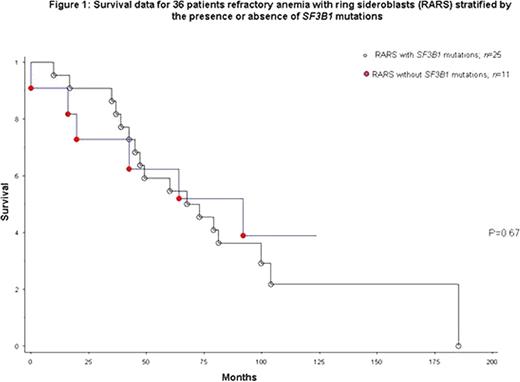Abstract
Abstract 460
SF3B1 mutations were recently reported to occur in myelodysplastic syndromes (MDS), especially in the presence of ring sideroblasts (RS) (Papaemmanuil et al. Leukemia Research 2011, Volume 35, Supplement 1, page S18). We sought to accurately define the interaction between SF3B1 mutations, bone marrow morphology, karyotype and prognosis in MDS with ≥15% RS (MDS-RS).
Mayo Clinic databases and cell banks were queried to identify patients with MDS and ≥15% RS (MDS-RS). All study patients were required to have undergone bone marrow examination and cytogenetic evaluation at diagnosis. Pathology slides, including iron stains, were centrally re-reviewed to accurately quantify bone marrow RS percentage and confirm World Health Organization (WHO) morphologic categories. Detailed analysis of clinical and cytogenetic parameters was performed to risk stratify patients according to the revised International Prognostic Scoring System (IPSS-R) (Greenberg et al. Leukemia Research 2011, Volume 35, Supplement 1, page S6). All patients were annotated for their mutational status involving JAK2, MPL and IDH. PCR sequencing was used to identify SF3B1 mutations.
The study is currently ongoing; to date, results are availab1e in 88 patients (median age 72 years, 69% males) including 36 (41%) patients with refractory anemia with RS (RARS), 36 (41%) with refractory cytopenia with multilineage dysplasia and ≥15% RS (RCMD-RS), 11 (12%) with refractory anemia with excess blasts (RAEB)-1 and ≥15% RS (RAEB1-RS) and 5 (6%) with RAEB2-RS. Median (range) values were 9.1 g/dL (5.8–15.7) for hemoglobin, 4.1 × 109/L (1.2–35.2) for leukocytes and 164 × 109/L (6–585) for platelets. IPSS-R risk categories were 20% very good, 49% good, 11% intermediate, 3% poor and 16% very poor. Karyotype was normal in 60%, other very good/good risk 16%, intermediate-risk 2%, and poor/very poor in 22%; 14% had monosomal karyotype (MK). Six (7%), four (5%) and zero (0%) patients displayed IDH, JAK2 or MPL mutations. Red cell transfusion need was documented in 27 (31%) patients.
SF3B1 mutations (all heterozygous) were detected in 40 (∼46%) of all 88 study patients: 25 (63%) K700E, 6 (15%) K666N/Q/R, 3 (8%) E622D, 2 (5%) H662D/Q, 2 (5%) Y623C, 1 (3%) R625C, and 1 (3%) T663I. One patient each displayed both SF3B1K700E and IDH2R140Q or SF3B1K700E and JAK2V617F. SF3B1 mutational frequencies were 69% for RARS, 36% for RCMD-RS, 18% for RAEB1-RS and 0% for RAEB2-RS (p=0.0007). SF3B1 mutations clustered with normal (59%) and other very good/good risk (57%) karyotype and were infrequent in poor/very poor karyotype (5%; p=0.0004). Additional significant correlations were noted between SF3B1 mutations and lower IPSS-R risk category (p=0.0004), advanced age (p=0.006), higher platelet count (p=0.0003).
To date, 68 (∼77%) deaths and 10 (∼11%) leukemic transformations have been documented. Median follow-up for living patients was 82 months. Univariate survival analysis considering all 88 study patients identified the following as strongly significant risk factors: IPSS-R (p<0.0001), WHO morphologic categories (p<0.0001), cytogenetic risk categories (p<0.0001), and transfusion need (p=0.0003). In multivariable analysis, only IPSS-R and transfusion need remained significant. In univariate analysis, the presence of SF3B1 mutations was significantly associated with better overall (p=0.04) and leukemia-free (p=0.03) survival; however, in both instances, significance was completely accounted for by WHO morphologic risk categorization and the morphology-adjusted p values were 0.6 and 0.2, respectively. In other words, when RARS and RCMD were analyzed separately, there was no additional prognostic value from the presence or absence of SF3B1 mutations (Figures 1 and 2; p=0.67 and 0.44, respectively).
SF3B1 mutations are prevalent in RARS and RCMD-RS but do not provide additional, WHO morphology-independent or IPSS-R-independent, prognostic information.
No relevant conflicts of interest to declare.
Author notes
Asterisk with author names denotes non-ASH members.



This feature is available to Subscribers Only
Sign In or Create an Account Close Modal